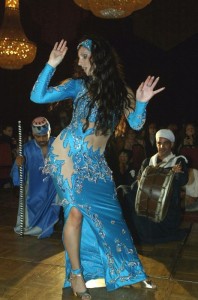
(AFP Photo / Amro Maraghi)
In a nightclub in Giza, heavy drum beats can be heard as Somaya enters the hall, barefoot. Dressed in a reddish bra and a flesh-colored skirt, both with beaded fringing, the Egyptian belly dancer performs flowing and sinuous movements on stage. New movements evolve with every beat of the music.
“Belly dancing is my passion and I depend on it to earn my living,” she says. Explaining how she discovered her talent, the dancer says she started practicing as a teenager. “I then took a lot of courses taught by professional belly dance trainers and after about three years I became a professional.”
Belly dancing (Raqs Sharqi) became popular in Cairo’s nightclubs in the 1940s. Casino Badia, in Cairo, was one of the country’s most famous cabarets at that time. Opened and run by a woman, it imitated European-style cabarets. During the 1950s, famous belly dancers including Samia Gamal, Tahyia Karioka and Naima Akef marked themselves as pioneers of belly dancing in Egypt. From 1960 to 1980, the booming Egyptian film industry centered around belly dancers. Since the 1980s, the Egyptian film industry bloomed with belly dance performances until other dancers, like Fifi Abdou, Sohair Zaki and Nagwa Fouad started to perform in a full live band and a stage set-up. These dancers continued to preserve the basic movements of belly dancing.
Many quivers
“There are many types of movements in belly dancing. The most important thing for a clever belly dancer is her ability to move her hips and thighs in time with the music,” says Somaya as she applies make-up before the performance.
Mohamed Moatasem, a belly dance trainer, agrees. He says the basic training for belly dancers focuses on how to move correctly and develop excellent muscle control. “We train the girls on how to exercise control of their leg muscles, and in bending their knees in synchrony with the movement of their hips,” he says, adding that the techniques of turns and spins are also among the basic movements belly dancers should learn.
Somaya has her favourite belly dancing moves; shimmies and shivers. “I love the shimmy. That’s what we call it, when you quiver your whole body or hips. I like to display how I can move my body to interpret rolls on the drums making fast and continuous movements. It’s a hard movement that not all belly dancers can master,” she says.
Somaya also likes awady movements. These are usually performed to classic Arabic music, and are fluid movements relying on the continuous motion of the body and the dancer’s ability to move in time with melodies and specific lyrics in songs. The movement is usually performed to classical Egyptian music like that of the famous singers Um Kolthoum and Abdel Halim Hafiz.
Mido, Somaya’s choreographer, says belly dancing requires some basic musical instruments. Percussive movements, which usually include lifts and drops of the ribs, shoulders and hips, necessitate the presence of ‘rhythm instruments’: doumbek or darabuka drums, riks (a type of tambourine) and Western-style drums with sticks belong to rhythm instrument family.
Mido says that the accordion is the best instrument for awady movements. He adds that the band should include instruments such as the ney, the qanun, and the violin. Keyboards, according to Mido, are mandatory. For Somaya’s performances, Mido relies on two keyboards, a violin, and an accordion to provide the music. He says it also reduces the cost of having all the basic musical instruments needed in for a belly dancer.
Hips on the beat
Professional belly dancers have to learn over 20 drum rhythms to be able to move their body according to the melodies, and thus be able to perform professionally on stage. The most popular include Maqsoum, Masmoudy, Saaidi, and Falahy. “For Maqsoum, a song like Gana Al-Hawa for Abdel Halim Hafez is played. For Masmoudy, we have two types: big and small. An example of the big Masmoudy melody would be the first part of “Ennaby” song,” Mido says.
Somaya knows all of the drum rhythms by heart. In nightclubs, belly dancers do not have a pre-set program as in weddings. “I start with music, and then I dance accompanied by a singer,” says Somaya. In average nightclubs, singers usually sing songs requested by clients.
“It is not about whether the belly dancer can dance properly or not. It is about how sexy she looks and how appealing her costume is,” Somaya says, speaking of the clients who come to watch her perform. “Honestly, if you as a belly dancer don’t make seductive moves whilst dancing, you won’t get clients,” she says. Arab and gulf visitors are commonly seen in Egyptian nightclubs. The belly dancer says the majority of customers come to “watch how sexy” the dancer is. She knows if the client watches her to enjoy the performance or enjoy her “sex appeal” according to the comments she hears from her customers or the stage manager after she ends her performance. “I can find a client coming up on stage to tell me that I need to be either “fatter or slimmer,” she explains, admitting that she has to make seductive moves while dancing or she won’t maintain her clients.
How much for an hour?
Belly dancers in Egypt are classified into four categories each with particular salaries from nightclubs or casinos, and there are different levels of venues. Weddings and five-star hotels are well-paid jobs for belly dancing, whereas nightclubs vary in pricing. An average belly dancer receives a minimum of EGP 5,000 for performing at a wedding; in a nightclub a dancer receives no more than EGP 2,000, but also receives a share of the money thrown at her by clients during her performance, which is called “Kate” in the Arabic slang used in night clubs. Commonly, a nightclub takes third the amount of money thrown. But this can vary, according to Somaya, between EGP 5,000 to EGP 15,000.
Ahmed Emam, a wedding planner who coordinates business agreements with belly dancers, says famous Egyptian dancers like Dina and Lucy earn a minimum of EGP 15,000 from their shows. Emam adds that the second category of belly dancers includes those who perform in weddings and five-star hotels. They are paid an average of EGP 6,000 for a one-hour dance. Foreign dancers, mainly Brazilians, Argentineans and Russians, make a little less than their Egyptian counterparts. “They are usually more in demand than Egyptians and dance more professionally,” says Emam, highlighting that some Egyptians enjoy watching how foreigners perform oriental belly dancing.

(AFP Photo)
Foreign belly dancers take it seriously
Somaya, surprisingly, says that foreign belly dancers have better potential than Egyptians. “They come to Egypt, attend workshops and take it seriously. They learn every move by heart so they perform perfectly,” she says, adding that Egyptian belly dancers depend on their instinctive ability to dance and therefore sometimes do not learn how to fully control their muscles.
According to Emam, all belly dancers in Egypt have to obtain a license from the performing arts trade union. He confirmed that even foreign belly dancers have to apply for licenses. To explain the procedure to be a licensed belly dancer, Somaya says she submitted an application with a copy of the contract from her work place, which has to be approved by the Ministry of Labour, and a clearance from the morals police (to prove she was never involved in any prostitution cases.
“It is usually easy to get a license nowadays,” says Emam. However, in 2003, the Egyptian government cancelled work permits for foreign belly dancers.
Moatassem Oraby, another wedding planner who has been working in the field for more than 30 years, says the belly-dancing field in Egypt is becoming more competitive. “The presence of foreign belly dancers has threatened many Egyptian dancers. They are cheaper and better than Egyptians,” he says.
Oraby explains that Russian dancers flocked to Egypt about 20 years ago, and that dancers from many Eastern European countries and the US come to Egypt to participate in belly dancing festivals.
Belly dancing costumes
Since the era of Samia Gamal and Sohair Zaki in the 1950s, dancers have been banned from showing their midriffs and must cover their belly buttons. Many dancers wear long gowns with sheer fabric cut-outs. Sometimes, embellishments are directly placed on the sleek lycra skirt. Most belly dancers perform with two different belly dance costumes and two folkloric garments. Somaya says belly dancers should be barefoot, but some perform in heels.
An average belly dancing costume could cost EGP 2,000, and some specially designed costumes for famous belly dancers could reach EGP 20,000. In Cairo’s Azhar neighbourhood, near Khan El-Khalili, various shops sell belly dance costumes for EGP 150 to EGP 400.
“These are made for tourists, not for professional belly dancers,” Somaya says. But Mahmoud Al-Sayed, a shop owner who sells belly-dancing costumes, says that he sells many costumes to amateur belly dancers performing in small casinos. “Many women come and buy costumes from here. Some of the costumers are amateur dancers, some are tourists, many are veiled housewives,” he says.
RudeTube: Belly dancing banned on Egyptian TV
Belly dancing in Egyptian media is only seen in films or TV wedding scenes. Egypt’s state television does not air belly dancing. In 2009, Islamist member of parliament Faird Ismail said that establishing state institutes to train belly dancers would “seriously challenge Egyptian social traditions and glaringly violates the constitution”.
In February 2013, Cairo’s Administrative Court ordered the closure of the Al-Tet channel, which showed only belly dance performances. The court closed the belly-dancing channel for broadcasting without a licence, but also because of claims that it helped to facilitate prostitution and sold sexual products that “aroused viewers”. A few months later, a belly dancing channel called Dom Tak aired similar belly dancing scenes showing Egyptian and foreign dancers, and featured adverts for adult products.
Mido says that the government’s crackdown on belly dancing channels is unfair. “It is not going to harm anyone. It just seems that the Muslim Brotherhood wants to end all entertainment in this country,” he says. He argues that there are many channels dedicated to sports or news, so why does the government not leave belly dancing channels for those who enjoy watching this style of dance.
It’s not all doom and gloom in Cairo’s belly dancing community, though. Somaya is optimistic that the art of belly dancing will continue to flourish within certain sectors of Egyptian society.
“Even if belly dancing is not shown on TV, customers who like belly dancing know where to go. We have our own clients who don’t want to give up this special art form,” she says.



